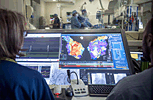Clinical Solutions
KGH first to use new cardiac ablation tech
January 18, 2017

KINGSTON, Ont. – A revolutionary new technology is now in use at Kingston General Hospital (KGH) that is improving the treatment of patients with complex cardiac conditions.
Known as the St. Jude Medical Ensite Precision cardiac mapping system, this technology is the first of its kind to be used in a North American hospital.
The new technology supports patients who require cardiac ablation surgery to restore a normal heart rhythm. It provides highly detailed models and maps of the heart that allow physicians to diagnose a wide range of irregular heart rhythms. It also expands procedural options for physicians so they can better tailor care for individual patients and helps guide physicians inside the heart during the procedure.
“This is an incredible tool that allows us to locate and treat within millimetre precision where in the heart the rhythm disturbance is,” says Dr. Ben Glover, a cardiologist at KGH and an assistant professor of cardiology at Queen’s University. “Because we can more accurately locate and treat short circuits in the heart, this leads to a quicker, more targeted procedure and is a more effective treatment for patients.”
During a catheter ablation procedure, several long, flexible tubes with wires are inserted into the heart. Diagnostic catheters record electrical information from the heart and display it in a three-dimensional model, which is used to study the abnormal rhythm.
Another catheter is then used for the actual ablation. The doctor positions the ablation catheter so it lies on or very close to the targeted tissue. The small area of heart tissue under the tip of the ablation catheter is heated by high-frequency energy, creating a lesion or tiny scar. As a result, this tissue is no longer capable of conducting or sustaining the arrhythmia.
“By moving the wires around the chamber of the heart we build up a map of the inside of the heart which allows us to precisely see what tissue we need to treat,” says Dr. Glover. “This results in a highly accurate procedure.”
Since first introducing this technology, it has been successfully used a number of times during procedures at KGH.
“As we continue to see an increase in the number and complexity of cardiac cases, this technology is a huge benefit for both patients and physicians. This state-of-the art system provides us with a new level of detailed anatomical and electrical information, allowing us to see inside the heart in an extremely accurate way,” says Dr. Glover.
The most common condition to cause an irregular heart rhythm, atrial fibrillation, affects approximately one in four Canadians and it’s anticipated that as the population ages, the number of patients who may require a cardiac ablation surgery will increase.
Many people with an irregular heart rhythm experience no symptoms while others may experience heart palpitations, tightness in the chest, shortness of breath, dizziness, light-headedness, fatigue, fainting and anxiety. Over time, untreated atrial fibrillation may lead to a stroke. Anyone who is concerned about their heart health should contact their family doctor.
